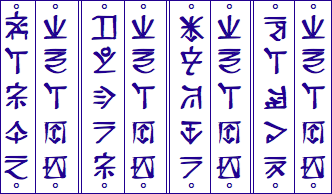| Smooth translation: |
Standing on the shore;
Drifting out to sea.
I wish that I could be,
Drifting out to sea.
All of my hopes and dreams,
Drifting out to sea.
I watch my wife's boat,
Drifting out to sea. |
| Translation of previous torch |
Standing on the island's shore,
Drifting off to sea.
I wish that I could be,
Drifting off to sea.
All of my hopes and dreams,
Drifting off to sea.
I watch my lover's boat,
Drifting off to sea. |
| Glossary/mini dictionary |
* a (part.) marks present tense, and that the subject of the sentence is new
or different (non-obligatory)
* aila (n.) ocean
* avame (n.) shore
* e (part.) the (definite article, sg.; attaches to prepositions); (part.)
marks present tense, and that the subject of the sentence is identical to the
subject of the previous sentence
* ei (pron.) I
* eine (n.) woman; (n.) wife (coll. A transitive noun: implies a spouse)
* eneta (n.) boat, ship
* fule (v.) to want, to desire
* fulele (v.) to want to, to desire to
* i (prep.) marks direct objects; marks general locations and/or times
* ie (contr.) contraction of /i/ and /e/
* -le (suf.) causative
* li- (pref.) marks the genitive (X liY = "X of Y")
* mata (v.) to see
* o (prep.) marks the genitive (X o Y = "X of Y")
* oloko (v.) to dream; (n.) dream
* poiu (prep./adv.) away, away from, outside of, out
* tiku (v.) to stand, to stand up
* u'upi (v.) to drift
* u'upi...poiu (v.) to drift away |
| Grammar notes |
# Typological facts: word order = VSO; prepositional; NG; NA; NR.
# A PP can be moved to the front of a clause, but otherwise word order is
maintained.
# Kamakawi is a pro-drop language. If the subject marker /e/ or /ae/ is used,
the subject may be omitted, as it can be retained from the previous clause.
# Subject status markers let the hearer know if the subject of the new sentence
(embedded or otherwise) is the same as the subject of the previous sentence.
There are three possibilities: (1) It's identical; (2) it's from the previous
clause, but isn't the previous clause's subject; (3) it's brand new (or more
than a clause old). To mark these statuses, a particle is used which preposes
the verb. The markers are as follows:
* (k)e = (1)
* (k)ae = (2)
* (k)a = (3)
Certain discourse particles (words like "because" and "so that") are suffixed
directly to these subject status markers. So if you had a sentence like Kale X
Y, it'd mean "Because Y did X" ("Kale" being /ka/, past tense same subject, plus
/-le/, "because").
# Adverbs occur sentence-finally, generally. Adverbs are sometimes used like
modals in English. For example, if you say Ka mama eine i nawa (PAST hug woman
PREP fish), it'd mean "The woman hugged a fish". If you say Ka mama eine i nawa
tou (PAST hug woman PREP fish can), it'd mean "The woman could hug a fish".
# If a noun phrase is unmistakably definite, it need not be accompanied by the
definite article /e/ (it usually does, but in verse, where things are a bit
looser, it can be left off).
# Where a verb has 2 arguments, the preposition /i/ marks the less agent-like of
the two. For this reason, it's used to cover a whole range of prepositional
functions, including spatial and temporal.
# Verbs are less static in Kamakawi than in English. A verb may be a verb, a
noun, a participle, or a verbal noun, depending on the context. When occurring
as a participle, it will generally look like a verb in a sentence without a
subject (the subject will most likely be implied somehow).
# Certain verbs take adverbial complements. They're listed in the lexicon as
X...Y. For these verbs, any objects and subjects come in between the members X
and Y. Otherwise, the two function as a single verb with a single meaning.
# When two vowels of the same quality occur next to one another, they're
separated by a glottal stop. |
